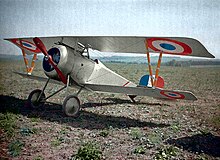History
79a Squadriglia of the Corpo Aeronautico Militare was one of Italy's original fighter squadrons. It was founded in November 1916 at the Central Flying School in Arcade, Italy. On 13 January 1917, it was deployed to Istrana, with its area of operations being the Asiago Plateau near the ongoing Battles of the Isonzo. The new unit flew its first combat mission on 20 January 1917. [1]

The Italian Corpo Aeronautico Militare was formed as part of the part of the Regio Esercito on 7 January 1915, incorporating the Aviators Flights Battalion (airplanes), the Specialists Battalion (airships) and the Ballonists Battalion. Prior to World War I, Italy had pioneered military aviation in the Italo-Turkish War during 1911–1912. Its army also contained one of the world's foremost theorists about the future of military aviation, Giulio Douhet; Douhet also had a practical side, as he was largely responsible for the development of Italy's Caproni bombers starting in 1913. Italy also had the advantage of a delayed entry into World War I, not starting the fight until 24 May 1915, but took no advantage of it so far as aviation was concerned.

Istrana is a comune (municipality) in the Province of Treviso in the Italian region Veneto, located about 35 kilometres (22 mi) northwest of Venice and about 12 kilometres (7 mi) west of Treviso. As of 31 December 2004, it had a population of 8,223 and an area of 26.3 square kilometres (10.2 sq mi).

Asiago is the name of both a major Italian Protected Designation of Origin (PDO) cheese and a minor township in the surrounding plateau region in the Province of Vicenza in the Veneto region of Northeastern Italy. It is near the border between the Veneto and Trentino-Alto Adige/Südtirol regions in the foothills of the Alps, and about equidistant (60 km) from the major cities of Trento to the west and Vicenza to the south. The Asiago region is the origin of Asiago cheese. The town was the site of a major battle between Austrian and Italian forces on the Alpine Front of World War I. It is a major ski resort destination as well as the site of the Astrophysical Observatory of Asiago, operated by the University of Padua.
On 28 March 1917, 3a Sezione was detached for city defense duties. On 10 April 1917, the squadron was attached to 10o Gruppo. A month later, it was transferred to 7o Gruppo. On 2 June 1917, Antonio Reali scored his first aerial victory for the squadron's initial success. [1]
Capitano Antonio Reali was an Italian World War I flying ace credited with eleven confirmed aerial victories, and 22 unconfirmed victories. He served in the Regia Aeronautica Reserves from 1923 to about 1940.
On 3 December 1917, the squadron was posted to the 15o Gruppo. In June 1918, it was assigned to the Massia da Caccia (Fighter Mass) before passing to control of the 23o Gruppo. The squadron served through war's end. Its wartime record was 4,411 combat sorties flown, with 47 victories achieved in 227 aerial combats. The squadron had suffered five killed.
A sortie is a deployment or dispatch of one military unit, be it an aircraft, ship, or troops, from a strongpoint. The sortie, whether by one or more aircraft or vessels, usually has a specific mission. The sortie rate is the number of sorties that a given unit can support in a given time. The term is an evolution of the concept of "sortie" in siege warfare.






